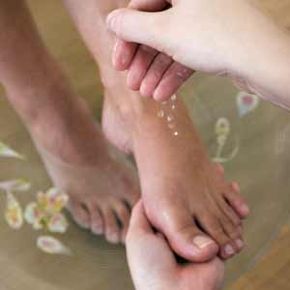Years ago, no one thought of walking as "real" exercise. Now we know that it's not just a good workout, it's one of the best fitness activities for the feet and for the whole body, and it's a good way to protect your feet from the injuries that can occur with more strenuous exercise.
Many national health organizations, including the President's Council on Physical Fitness and Sports; the Centers for Disease Control; the American College of Sports Medicine; The National Heart, Blood, and Lung Institute; and the U.S. Department of Agriculture, have issued fitness guidelines praising the benefits of moderate exercise and specifically recommending walking.
First, however, it's important to say a few words about running -- what most people used to think of as "real" exercise -- and the feet. If you're a runner, with each stride you take, you place pressure on the joints of your foot equal to three to four times your normal body weight. That's quite a shock even for healthy feet. For people who already have bone or joint problems, running is even more harmful. And the impact of your feet pounding the pavement intensifies the pressure your shoes exert on foot problems such as bunions, hammertoes, corns, injured toenails, or bruised heels.
The Benefits of Walking
Walking aids weight loss. An average-weight person burns close to 100 calories a mile while walking, about the same amount per mile you would burn running. Your metabolism, or calorie burning, not only speeds up during the time you're actually walking, your body continues to burn fat at a higher-than-usual rate for up to six hours after you have completed your workout.
But walking improves your overall health in an even more important way: If you do it briskly (at a rate of between three and five miles per hour) and continuously for at least 20 to 30 minutes, it becomes an aerobic exercise. An exercise is aerobic if you can do it rhythmically and continuously and at a brisk enough pace to force your heart and lungs to work harder to supply your major muscles with oxygen. By forcing your cardiovascular system to pump blood and oxygen continuously throughout your body, aerobic exercise stimulates and strengthens the heart, lungs, and muscles.
It also promotes circulation and, when done on a regular basis, helps to control blood cholesterol levels, which in turn can help keep your arteries clear and healthy. The result is that by engaging in a regular aerobic exercise program, you'll be less likely to suffer from high blood pressure, heart disease, or heart attack. Many studies have shown that people who briskly walk for 30 minutes or more most days of the week reduce their risk of heart attack significantly.
There's more: A walking routine can help you stop smoking. It reduces the craving for nicotine and helps to counteract the sluggish feeling many people have when they first give up cigarettes. It can improve your lung capacity, which is especially important for asthmatics, and can even help to relieve constipation. (Asthmatics and other individuals with significant health problems, however, should be sure to talk to their doctor before beginning any exercise program.) Some studies have even indicated that a fitness walking program can play a part in helping to prevent certain types of cancer.
But in addition to all these great incentives, regular walking is good specifically for your feet. It strengthens the foot muscles and conditions them so that if you do subject them to unusual strain, they're less likely to be injured or to ache afterward. Because walking continuously moves joints without placing them under great pressure, it is often recommended as a good way for people with foot-joint problems -- including arthritis, gout, and bunions -- to get some exercise.
Also, because walking is what's called a "weight-bearing exercise" -- the demands of the exercise are increased by gravity because you're toting around your own weight -- it strengthens the bones in your feet, lessening the chance of fracture and helping to prevent severe bone problems such as osteoporosis. A study at Washington University in St. Louis showed that postmenopausal women actually increased their bone mass through a regular walking routine.
Getting Started
A walking program, or any other fitness program, should be embarked upon gradually, especially if you've never been very active. Plunging head first -- or feet first -- into a long, vigorous walk after months or years of inactivity will result not in fitness or weight loss, but pain.
Begin a walking routine very modestly and, over weeks and months, slowly increase its intensity. You might start out by walking for 20 minutes a day, three days a week, and gradually add to both the length and frequency of your walks so that, after the first three or four months, you are walking for 45 minutes a day, five days a week. The latter schedule -- if you walk at a pace of at least three miles an hour -- should produce all the aerobic benefits mentioned in the first part of this page. But even if you can never walk this far or this fast, you will still improve the strength of foot muscles and bones (and your overall health) by walking.
To prevent injury, be sure to do stretches and other light exercises (such as those recommended on the foot stretches page) before and after your walk.
There are three main styles of walking: slow (nonaerobic) walking, fitness (aerobic) walking, and something called race walking, which is that funny-looking style you've seen at the Olympics.
Race walking is, indeed, a sport and is characterized by straight legs (no bending at the knees), swiveling hips, pumping arms bent at the elbows, and speeds as high as seven or eight miles an hour. It should be attempted only by people who are already in very good physical condition. You do not, however, need to become a race walker to achieve fitness through walking. And if you are an average fitness walker, you don't need to use wrist and ankle weights while you walk in order to increase the difficulty of your workouts. They're not necessary for aerobic fitness, and if your bones and muscles can't hold up under the added strain, you may create new injuries and other lasting problems for yourself.
Even veteran walkers can sometimes overdo it. While you're out walking, pay attention to the signals your body is sending you. You should never be so short of breath that you can't hold a conversation. If you feel pain in any part of your foot or leg, stop -- you may have strained a muscle or injured yourself in some other way, or you may be becoming dehydrated and need fluids.
To decrease the likelihood that you will overdo a walking routine on impulse -- and to increase your chances of getting help for injuries if you do -- walk with a partner or join a walking club. To find out if there's a club in your area, call your local YMCA or YWCA, inquire at health clubs, or look for notices posted in schools, libraries, and grocery stores. Many shopping malls also sponsor walking groups that walk inside the mall either before the stores open or after they close.
A few final cautions for certain readers: Never begin any fitness program without consulting a doctor if you:
- are older than 50 and not accustomed to regular exercise.
- are significantly overweight.
- have a history of heart trouble or high blood pressure.
- have arthritis or another bone or joint problem.
- have a medical condition, such as diabetes, that needs every day attention.
- are on a prescription drug that might interfere with perspiration.
Many of these people are actually among those who can benefit most from walking, but a doctor should help them choose the length and intensity of their walking routines.
Now you know how to protect your feet while exercising, but have you ever thought about protecting them while you're just standing around? Continue to the next page to learn more.
To learn more about treating and avoiding problems with your feet, visit:
- Everyday Foot Problems: Discover what causes some of the most commonly encountered foot problems, as well as how to treat or avoid them.
- Foot Injuries: Learn about common foot injuries and first aid techniques for feet -- from blisters to broken bones -- with this informative article.


